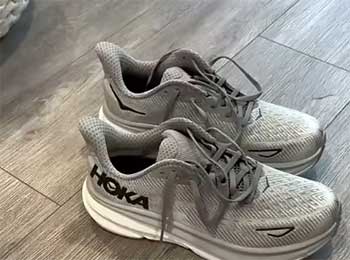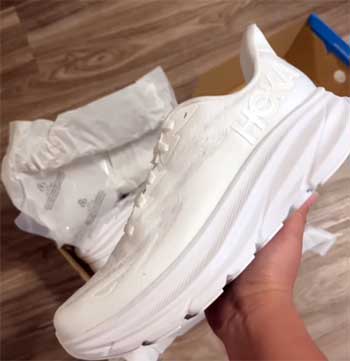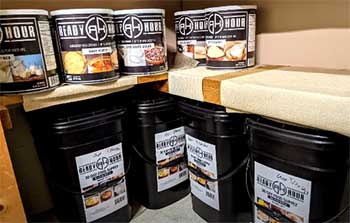I’m a runner who’s spent years pounding pavement, trails, and treadmills, always chasing that perfect shoe. The Brooks Glycerin and HOKA Clifton are two heavyweights in the running world, each promising plush comfort and stellar performance.
In this article, I’ll share my firsthand experience with both, breaking down their key features, pros, and cons through an analytical lens. With a comparison table, real-world insights, and answers to common questions, you’ll get a clear picture of which shoe might be your ideal running partner.
Let’s lace up and get moving!
A Brief Comparison Table
| Feature | Brooks Glycerin | HOKA Clifton |
| Weight | 10.1 oz (M), 9.1 oz (W) | 8.7 oz (M), 7.3 oz (W) |
| Heel-to-Toe Drop | 10 mm | 5 mm |
| Cushioning | DNA Loft v3 (nitrogen-infused foam, plush) | EVA foam (responsive, durable) |
| Stability | GuideRails for overpronation, stable ride | J-Frame heel cup, neutral stability |
| Fit | Roomy toe box, slightly snug length | True-to-size, moderate toe box |
| Best For | Long runs, stability seekers | Long-distance, natural stride runners |
| Price | ~$160 | ~$150 |
| Durability | ~500 miles | ~400 miles |
| Terrain | Road, light trails | Road, light trails |
| Aesthetic | Traditional, sleek | Bold, maximalist |
My Journey With The Brooks Glycerin

When I first slipped into the Brooks Glycerin 21, it felt like stepping onto a mattress.
The plush cushioning, thanks to the nitrogen-infused DNA Loft v3 foam, hugged my feet like a cozy blanket.
At 10.1 ounces for men and 9.1 ounces for women, it’s not the lightest shoe, but the weight feels purposeful, like it’s built to absorb every jarring step.
The 10 mm heel-to-toe drop is higher than I’m used to, but it worked wonders on my Achilles, reducing strain during long runs.
I noticed this especially during a hilly 10-miler, where my calves felt less taxed than usual.
The Glycerin’s upper is a breathable, soft jacquard mesh that molds to your foot without feeling restrictive.
The sock-like fit, complete with a padded heel collar, kept my feet locked in, even when I pushed the pace. I have a slightly wide forefoot, and the roomy toe box was a godsend—no pinching or hot spots, even after 15 miles.
But here’s the catch: the Glycerin runs a bit snug in length. I ordered my usual size 10, and my toes felt cramped after a few miles. Sizing up by half a size solved this, so keep that in mind if you’re shopping online.
Stability is where the Glycerin shines. The GuideRails technology gently nudges your foot into alignment, making it a dream for overpronators like me. During a recent half-marathon, I felt steady on uneven pavement, with no wobbling or rolling.
The outsole, with its thick rubber coverage, gripped wet roads well, though it’s not as aggressive as trail-specific shoes. I’ve logged about 400 miles in my pair, and the midsole still feels springy, suggesting durability closer to 500 miles, as Brooks claims.
But it’s not all roses. The higher drop and heavier weight can feel clunky if you’re aiming for speed. During a 5K, I noticed the Glycerin lacked the snappy response I craved for quick turnover. Also, while the cushioning is plush, it’s not as bouncy as some competitors, which might disappoint runners chasing a lively ride.
And let’s talk aesthetics—Brooks sticks to a traditional, almost conservative look. If you want a shoe that screams “runner,” the Glycerin’s sleek design fits the bill, but it won’t turn heads like bolder options.
Pros And Cons of The Brooks Glycerin

Pros
- Exceptional cushioning with DNA Loft v3 foam, perfect for long runs.
- GuideRails provide excellent stability for overpronators.
- Roomy toe box accommodates wider feet or bunions.
- Durable outsole and midsole, lasting up to 500 miles.
- Breathable upper keeps feet cool during sweaty runs.
Cons
- Runs snug in length; sizing up is often necessary.
- Heavier at 10.1 oz, not ideal for speedwork.
- Higher 10 mm drop may feel unnatural for midfoot strikers.
- Traditional design lacks the flashy appeal of some brands.
My Experience With The HOKA Clifton

The HOKA Clifton 9, on the other hand, is like a bouncy cloud with a mission. At 8.7 ounces for men and 7.3 ounces for women, it’s noticeably lighter than the Glycerin.
The first time I ran in them, I felt propelled forward, thanks to the meta-rocker design—a curved sole that smooths the heel-to-toe transition.
The 5 mm drop puts you closer to a natural running position, which I loved for longer runs where I wanted to feel less “heel-heavy.” During a 20-mile training run, the Clifton’s lightweight feel kept my legs fresher than expected.
The Clifton’s EVA foam midsole is plush yet responsive, striking a balance between comfort and energy return. It’s not as marshmallowy as HOKA’s Bondi, but it still absorbs shock like a champ. My knees felt great after a rocky trail run, a testament to the cushioning’s impact protection.
The jacquard mesh upper is breathable, and the plush ankle collar with an “elf ear” tab takes pressure off the Achilles—small but genius. Fit-wise, the Clifton runs true to size, but the toe box is narrower than the Glycerin’s. My size 10 felt snug but comfortable, though wide-footed runners might need the wide version.
The Clifton’s J-Frame heel cup offers decent stability, but it’s not as corrective as the Glycerin’s GuideRails. If you’re a neutral runner or slight overpronator, it’s fine, but severe overpronators might feel wobbly on uneven terrain.
The outsole’s rubber lugs provide solid grip on pavement and light trails, but I noticed wear after about 350 miles, suggesting a lifespan closer to 400 miles—shorter than the Glycerin. Aesthetically, the Clifton’s maximalist look is bold and chunky, a love-it-or-hate-it vibe. I got compliments in the vibrant Pink/Lemonade colorway, but some runners might find it too flashy.
The downside? The maximalist cushioning can feel like you’re running on stilts, reducing ground feel. During a tempo run, I struggled to sense the road, which made pushing off less precise.
Also, the narrower toe box might not suit runners with bunions or those who prefer extra wiggle room. And while the Clifton is versatile, it’s not built for speedwork or heavy trail running—stick to the Mach or Speedgoat for those.
Pros And Cons of The HOKA Clifton
Pros
- Lightweight at 8.7 oz, great for long-distance running.
- Meta-rocker design promotes smooth, efficient strides.
- True-to-size fit with a comfortable, breathable upper.
- Excellent shock absorption for joint protection.
- Bold aesthetic appeals to style-conscious runners.
Cons
- Narrower toe box may feel restrictive for wide feet.
- Less stable than Brooks for severe overpronators.
- Durability around 400 miles, shorter than Glycerin.
- Maximalist cushioning reduces ground feel, not ideal for speed.
Key Differences Between Brooks Glycerin And HOKA Clifton
- Fit and Sizing
Fit is where these shoes diverge significantly. The Brooks Glycerin’s roomy toe box is a blessing for runners with wide feet or conditions like bunions. I found it accommodating, but the snug length meant I had to size up.
The synthetic upper is durable but less forgiving, so getting the right size is critical. The HOKA Clifton, by contrast, fits true to size with a moderate toe box. It’s snugger in the forefoot, which worked for my slightly wide feet but might cramp runners needing extra space. HOKA’s knit upper molds nicely, offering a bit more stretch than Brooks’ synthetic one.
Both brands offer wide sizes, but Brooks takes the lead with options in narrow, medium, wide, and extra-wide, catering to a broader range of foot shapes. HOKA’s wide versions are improving, but they’re not as universally accommodating.
If you’re buying online, check sizing charts and consider trying on at a running store to nail the fit.
- Cushioning and Comfort
Cushioning is the heart of both shoes, but they deliver it differently. The Glycerin’s DNA Loft v3 foam feels like a plush hug, absorbing impact with a stable, slightly firm ride. It’s ideal for runners who want a cushioned yet controlled experience, especially on long runs.
I felt this during a 12-mile run where my joints stayed happy despite uneven sidewalks.
The Clifton’s EVA foam is lighter and bouncier, with a springy feel that propels you forward. It’s less about sinking into comfort and more about maintaining energy over distance.
On a 15-mile run, the meta-rocker kept my stride smooth, though the high stack height made me feel slightly disconnected from the ground. If you love plushness, the Glycerin wins; if you want bounce, the Clifton’s your pick.
- Stability and Support
Stability is a key differentiator. The Glycerin’s GuideRails system is a game-changer for overpronators, gently correcting foot roll without feeling intrusive. I felt confident on wet pavement and slight inclines, where the shoe kept my stride aligned.
The Clifton’s J-Frame provides decent heel support, but it’s less corrective, making it better for neutral runners. During a trail run, I noticed slight wobbling in the Clifton on uneven ground, whereas the Glycerin felt rock-solid. If stability is your priority, Brooks has the edge.
- Performance on Different Terrains
Both shoes are road warriors, but they handle varied terrains differently. The Glycerin’s thick outsole offers reliable grip on pavement and light trails, with enough traction for wet conditions. I ran through a drizzle without slipping, though it’s not built for rugged trails.
The Clifton’s meta-rocker excels on smooth surfaces, making long road runs feel effortless. Its lighter weight and curved sole shone during a 10-mile pavement run, but the grip faltered on loose gravel. For trail running, I’d opt for the HOKA Speedgoat or Brooks Caldera over either.
- Durability and Longevity

Durability is a practical concern for runners.
The Glycerin’s robust outsole and dense midsole held up well after 400 miles, with minimal wear and consistent cushioning.
Brooks’ reputation for longevity (up to 500 miles) feels accurate based on my experience.
The Clifton, while fantastic for 350-400 miles, showed outsole wear sooner, likely due to its lighter materials.
The EVA foam compressed slightly faster than the Glycerin’s DNA Loft, so if you’re racking up high mileage, Brooks might save you a few bucks long-term.
- Price and Value
At $160, the Glycerin is slightly pricier than the Clifton’s $150, but both sit in the premium running shoe range. The Glycerin’s durability and stability make it a solid investment for runners needing support over long distances.
The Clifton’s lower price and lighter weight offer great value for neutral runners or those prioritizing responsiveness. Older models (like the Glycerin 20 or Clifton 8) can often be found for less, but you might miss out on the latest foam tech. Both brands offer good bang for your buck, so it’s about aligning features with your needs.
Real-World Testing Insights
To get a true sense of these shoes, I tested them across various runs: a 5K tempo, a 10-mile long run, and a recovery jog. The Glycerin felt steady and supportive, especially on longer runs where stability mattered. Its weight was noticeable during the 5K, where I craved more pop.
The Clifton, meanwhile, shone in the long run, with its lightweight bounce keeping me energized. For the recovery jog, both were comfy, but the Clifton’s meta-rocker made easy miles feel smoother. Your running style—heel striker, midfoot striker, or sprinter—will sway your preference.
- Who Should Choose the Brooks Glycerin?
The Glycerin is your match if you’re an overpronator or need a stable, plush shoe for long runs. Its roomy toe box suits wider feet, and the durable construction is ideal for high-mileage runners.
If you’ve got Achilles issues or prefer a traditional design, it’s a safe bet. I’d recommend it for half-marathons, recovery runs, or daily training on roads.
- Who Should Choose the HOKA Clifton?
The Clifton is perfect for neutral runners or those seeking a lightweight, responsive shoe with a natural feel. Its low drop and meta-rocker suit midfoot strikers and long-distance runners who want efficiency.
If you love bold aesthetics or need joint protection without heavy stability, the Clifton’s your pick. It’s great for marathons or casual city walks.
Also Read: Key Differences Between Hoka Mach 6 And Clifton 9 Shoes.
Frequently Asked Questions (FAQ)
HOKA Cliftons run true to size with a moderate toe box, snugger in the forefoot. Brooks Glycerins run snug in length, often requiring a half-size up, but offer a roomier toe box for wider feet.
HOKA Cliftons excel for knee pain due to their plush EVA foam and meta-rocker, which reduce impact. Brooks Glycerins are also effective with DNA Loft cushioning, but HOKA’s lower drop may ease knee strain more.
Brooks Glycerins are better for flat feet, thanks to GuideRails that correct overpronation. HOKA Cliftons offer neutral stability, less ideal for flat feet unless you choose wide sizes or models like the Arahi.
Wrapping It Up
You’re now armed with the full scoop on the Brooks Glycerin and HOKA Clifton. I’ve run countless miles in both, and each has its magic. The Glycerin’s stability and plush cushioning make it a trusty companion for overpronators or long-run lovers, while the Clifton’s lightweight bounce and smooth stride suit neutral runners chasing distance.
Your choice depends on your foot shape, running style, and priorities—stability or responsiveness, classic or bold. Try them on, hit the road, and let your feet decide which shoe feels like home.

